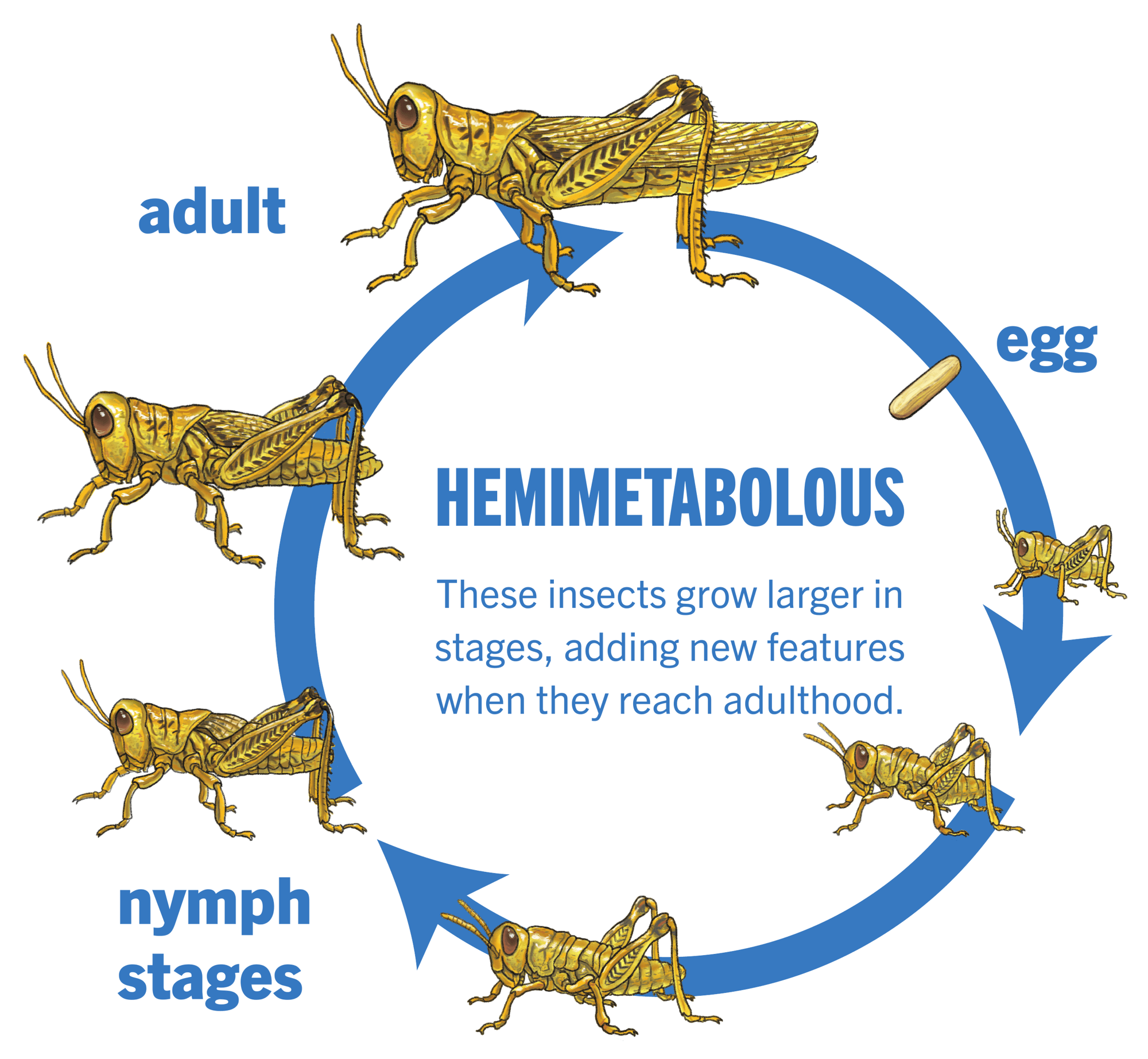What Is An Insect?
Insects are the most diverse group of animals.
They are arthropods: animals with a hard external skeleton, or exoskeleton. An exoskeleton is like a suit of armor, made of hardened plates with flexible joints that allow the animal to move. Arthropods also include animals like spiders, centipedes, crabs, and lobsters. Insects come in many shapes and sizes, and most have three main body parts, two antennae, and six legs.
Insect Diversity
A small sampling of the vast diversity of insects. How many can you identify?
Download the identification key - PDF | 8.3MB
Insect Life Cycles
An insect’s skeleton is on the outside, so it cannot grow with the body. This means they have to shed their skin, or molt, in order to grow. Once an insect becomes an adult, it usually does not grow any more.
Additionally, many insects go through a process called metamorphosis as they grow. During metamorphosis, the insect changes form through a series of stages. There are two main types of metamorphosis.
Incomplete metamorphosis:
In incomplete metamorphosis (or, hemimetabolous development), the insect grows up in three stages: egg, nymph, and adult.
The nymph often looks similar to the adult, but has no wings or reproductive organs. The nymph will molt many times, looking more like an adult each time. On its very last molt, the nymph will gain wings and reproductive organs and become an adult.
Complete metamorphosis:
In complete metamorphosis (or, holometabolous development), the insect grows up in four stages: egg, larva, pupa, and adult.
A larva looks nothing like an adult. For example, a caterpillar larva looks nothing like the butterfly that it will become. Larva eat and grow until they are big enough to form a pupa. The pupa is a resting stage with limited movement. Inside the pupa, the body is broken down and transforms into the adult, which then eventually emerges from the pupa.
This development process occurs in about 90% of all insects, including butterflies and beetles.
Mimicry: The Art Of Deception
Narrow Headed Marsh Fly
Helophilus fasciatus
Look-Alikes
Some insects protect themselves by mimicking more dangerous insects. Harmless flies might imitate the patterns of stinging wasps, and some butterflies are colored like other, more toxic species.
These insects don’t have the venom or toxins to back up their dangerous looks, but predators don’t know that!
Monarch Butterfly
Danaus plexippus
Viceroy
Limenitis archippus
Giant Malaysian Leaf Insect
Pulchriphyllium giganteum
Predators can be mimics, too! By masquerading as flowers or plants, they can ambush unsuspecting prey.
Orchid Mantis
Hymenopus coronatus
Camouflage
Some insects disguise themselves as other objects, like leaves, sticks, and even bird poop! To avoid predators, these camouflaged creatures might even look like decaying leaves with holes and missing chunks. To complete the disguise, these insects stay very still, or only move slowly as though they are being gently blown by the wind.
Uropyia Moth
Uropyia meticulodina
Beautiful Wood Nymph
Eudryas grata
Eyespots
If hiding doesn’t work, a flashy pair of eyespots might do the trick! The startling reveal of a hidden pair of “eyes” draws attention away from vulnerable body parts, confusing the predator long enough for an insect to escape.
Io Moth
Automeris io
Insects Are Important!
Silkworm on green mulberry leaf. It is the larva or caterpillar of the domestic silkmoth (Bombyx mori).
“If all mankind were to disappear, the world would regenerate back to the rich state of equilibrium that existed ten thousand years ago. If insects were to vanish, the environment would collapse into chaos.”
- E. O. Wilson
Insects are found in every terrestrial environment on Earth, and terrestrial ecosystems everywhere in the world depend upon them.
Without insects as pollinators, we would have far fewer flowering plants. This includes more than a hundred important crops we rely on every day for food, from coffee, chocolate, and berries to apples and tomatoes. Insects also recycle and decompose organic matter, keeping dung, dead plants, and animals from piling up around us. As they pollinate, consume, and recycle, insects create and fertilize our soils, disperse the seeds and spores of plants and fungi, and provide an important food source for other animals.
Human society depends on insects, too. Aside from pollinating the plants that we eat, insects create many important substances, including honey, lacquer, silk, wax, and dye. Insect-produced substances such as silk were vital historically. Woven silk from silkworms (Bombyx mori) in ancient China led to the creation of the Silk Road—the world’s first major trading route, central to economic and cultural interactions between Asia and Europe.
Although insects can be incredibly destructive to agriculture and infrastructure by eating crops or spreading disease, their services far outweigh their damages.
It is estimated that in the US alone, insects provide $57 billion dollars of services to society every year. Insects are the primary food source for a huge variety of animals, including some amphibians, reptiles, fish, birds, and even mammals. Insects’ role in the food web is so important that declining insect populations could cause many food webs to collapse. Insects are a rich source of protein and vitamins, and they are also an important source of food for many people around the world.
Advancement of Science
Insects are important model organisms in the advancement of science. Many concepts in biology were first studied or are best known in insects, from genetics and behavior to evolution. Chemistry and physics have relied heavily on insects as models to help inspire many innovations in flight, fluid dynamics, and medicine. Additionally, insects are used directly in medicine. For example, maggots (fly larvae) have been used to treat wounds and prevent gangrene because they only eat dead flesh.
Insects aren’t just important; they are an essential silent force that keeps the world running. Insects could continue on in our absence without a second thought. But if insects were to vanish, the world as we know it would collapse.

















